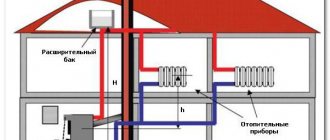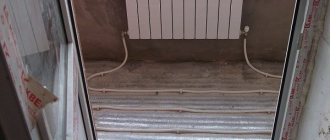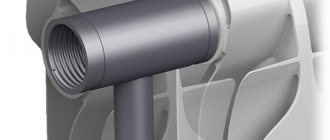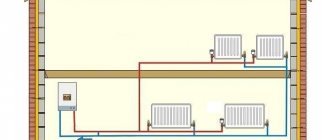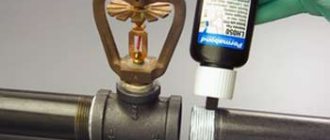Have a nice day!
As you know, the energy efficiency of a heating system depends not only on the power of the boiler and the number of radiators. This is a rather complex parameter, tied to the climate regime of the region, the materials from which the house is built, the quality and quantity of heating equipment and fittings. And heating pipes play the role of one of the “first violins” in the heating system.
What pipe diameter is best to use for heating a private house so that the coolant circulation in the circuit is as efficient as possible? As a rule, special programs are used for this, however, there are alternative concepts that allow you to perform this operation yourself. We will lift the “veil of secrecy” and tell you as simply as possible about complex calculation schemes that allow you to optimize the heating of your home so that it is warm and comfortable without having to throw money away.
The influence of pipe type and size on system performance
Is the pipe diameter really that important? As practice shows, extremely! A number of factors that ensure high efficiency of the entire circuit depend on it:
- Throughput and heat transfer coefficient. Those. the total volume of coolant located in the main during a certain period of time and subject to heating.
- Coolant pressure in the circuit, temperature and speed of its movement.
- Hydraulic losses that occur at the junctions of pipes and elements of different sections. The more such transitions, the greater the losses.
- Noise level of the heating system.
There are several types of diameter:
- External. Takes into account the cross-section of the internal cavity and the thickness of the pipe walls. Used when designing a heating system.
- Interior. Reflects the cross-sectional value of the internal cavity of the pipe. Determines the throughput of the pipeline.
- Nominal (conditional). Represents the average value of internal diameters obtained as a result of calculations.
In order for the heating system to work fully, in addition to the pipe cross-section, a number of other factors should be taken into account:
- Properties of the coolant, which is water, antifreeze or steam.
- The material from which the pipes are made.
- The speed of the coolant.
- Type of heating system: one- or two-pipe.
- Type of circulation: natural or forced.
What pipe diameter is best to use for heating a private home and why?
As you know, the energy efficiency of a heating system depends not only on the power of the boiler and the number of radiators. This is a rather complex parameter, tied to the climate regime of the region, the materials from which the house is built, the quality and quantity of heating equipment and fittings. And heating pipes play the role of one of the “first violins” in the heating system.
What pipe diameter is best to use for heating a private house so that the coolant circulation in the circuit is as efficient as possible? As a rule, special programs are used for this, however, there are alternative concepts that allow you to perform this operation yourself. We will lift the “veil of secrecy” and tell you as simply as possible about complex calculation schemes that allow you to optimize the heating of your home so that it is warm and comfortable without having to throw money away.
Pipe material
Before determining which pipe diameter is best suited for heating a private home, it is necessary to decide what material the pipeline itself will be made of. This allows you to determine the installation method, the cost of the project and predict in advance possible heat losses. First of all, pipes are divided into metal and polymer.
Metal
- Steel (black, stainless, galvanized).
They are characterized by excellent strength and resistance to mechanical damage. Service life – at least 15 years (with anti-corrosion treatment up to 50 years).
Operating temperature - 130⁰C. The maximum pressure in the pipe is up to 30 atmospheres. Not flammable. However, they are heavy, difficult to install (special equipment and significant time costs are required), and are susceptible to corrosion. A high heat transfer coefficient increases heat loss even at the stage of transporting the coolant to the radiators. Post-installation painting is required. The internal surface is rough, which provokes the accumulation of deposits inside the system.
Stainless steel does not require painting and is not subject to corrosive processes, which significantly extends the life of the pipes themselves and the heating circuit as a whole.
- Copper.
The maximum temperature of the working environment is 250⁰C. Working pressure – 30 atmospheres or more. Service life – more than 100 years. High resistance to media freezing and corrosion.
The latter imposes restrictions on the combined use of copper with other materials (aluminum, steel, stainless steel); Copper is only compatible with brass. The smoothness of the internal walls prevents the formation of plaque and does not impair the throughput of the pipeline, which reduces hydraulic resistance and makes it possible to use pipes of smaller diameter. Plasticity, light weight and simple connection technology (soldering, fittings). The small thickness of the walls and connecting fittings eliminates hydraulic losses.
The most significant drawback is the extremely high cost; the price of copper pipes is 5-7 times higher than the price of plastic analogues. In addition, the softness of the material makes it vulnerable to mechanical particles (impurities) in the heating system, which, as a result of abrasive friction, lead to wear of the pipes from the inside. To extend the life of copper pipes, it is recommended to equip the system with special filters.
The high thermal conductivity of copper requires the installation of insulating sleeves to prevent heat loss, but it also makes it an indispensable material for underfloor heating systems.
Polymer
They can be polyethylene, polypropylene, metal-plastic. Each modification has its own technical characteristics depending on the production technology, additives used and the specific structure.
Service life – 30 years. Carrier temperature - 95⁰C (short-term - 130⁰C); Excessive heating leads to pipe deformation, reducing service life. They are characterized by insufficient resistance to freezing of the coolant, as a result of which they rupture. The smoothness of the internal coating prevents the formation of plaque, thereby improving the hydrodynamic performance of the pipeline.
The plasticity of the material allows pipes to be laid without cutting, thereby reducing the number of fittings. Plastic does not react with concrete and does not rust, which allows you to hide the heating pipe in the floor and install “warm floors”. A special advantage of plastic pipes is their good sound insulation properties.
When exposed to high temperatures, polyethylene pipes are prone to significant linear expansion, which requires the installation of additional compensation loops and attachment points.
Polypropylene analogues must contain an “anti-diffusion layer” in their structure to prevent airing of the circuit.
The pressure level in the circuit determines not only the diameter of the polymer pipes, but also the wall thickness, which varies in the range from 1.8 to 3 mm. Fitting connections simplify installation of the circuit, but increase hydraulic losses.
When deciding which diameter to choose, you should take into account the specific markings of various pipes:
- plastic and copper are marked by external section;
- steel and metal-plastic - internally;
- often the cross section is indicated in inches; to carry out the calculation they need to be converted into millimeters. 1 inch = 25.4 mm.
To determine the internal diameter of the pipe, knowing the dimensions of the external section and wall thickness, you should subtract twice the wall thickness from the external diameter.
Materials and types of heating pipes
The correct choice of pipes affects many system performance characteristics. Of course, starting from heat transfer and ending with the volume of energy resources consumed. Here you need to remember about such an indicator as the heat loss of the system. Since this directly depends on what these same pipes are made of.
Today the most commonly used are:
- Pipes made of various types of steel;
- Polypropylene;
- Copper.
Until recently, steel was the only pipe material available. Today, although steel pipes are considered the most durable and reliable, they are mainly used in open systems. But, despite the large range of products, pipes of small and medium diameter are mainly used in low-rise housing construction. And sizes over 100 mm are mainly used for the manufacture of registers, and not for laying highways.
Steel is used in two versions - the usual version made of ferrous metal and in the form of stainless steel. Today steel is used less. First, closed systems began to be used more and more instead of open ones. And secondly, installation requires special equipment and a qualified welder. Steel pipes are mainly used in small diameters. But this in turn raises other problems. For example, a high coefficient of hydraulic resistance, because during welding, sagging and narrowing are formed inside, which cannot be removed.
Polymer pipes
Polymer pipes are gradually replacing steel pipes due to their increasing availability and ease of use. For this material, many manufacturers provide a 15-year guarantee on the integrity of pipes and almost 20 years on connections. Soldering does not require high qualifications; it is enough to have a special soldering iron and watch 2-3 training videos. But this material also has its disadvantages. The first is the small range of products. For heating soldering in a private house, pipes with a maximum diameter of 75 mm are used. The second disadvantage is the correct selection of material. Quite often, pipes have a small wall, its thickness is often only 2.-2.3 mm, which is clearly not enough for a closed-type heating circuit with a pressure of 1.2-1.4 bar. The third point lies in the specifics of the material itself. It is not as rigid as metal, so they usually try not to use it for two-story houses.
Copper heating pipes
Copper heating pipelines were not very popular in the recent past, since this material is very difficult to work with. Unlike steel and polypropylene, copper is soldered, and not every welder knows how to do this correctly. But, be that as it may, copper is one of the best materials for heating. It heats the air perfectly, it is plastic and even when the water freezes, the pipeline does not immediately burst; copper is a plastic material and can stretch under water pressure. But on the other hand, copper is a very aggressive metal; when it comes into contact with aluminum, it begins to oxidize and begins the corrosion process. In addition, it is very expensive when compared to other types of materials.
Optimal size, temperature and pressure
When installing a small heating circuit of a standard type, some recommendations from experts will allow you to do without complex calculations:
- For pipelines with natural circulation of the carrier, it is recommended to use pipes with an internal cross-section of 30-40 mm. Increasing the parameters threatens with unreasonable coolant consumption, a decrease in the speed of its movement and a drop in intra-circuit pressure.
- Too small a pipe diameter will cause an overload inside the line, which can cause it to break through at the connecting elements.
- To ensure the required speed of movement of the coolant and the required pressure inside the forced circulation circuit, preference is given to pipes with a cross-section of no more than 30 mm. The larger the cross-section of the pipe and the longer the line, the more powerful the circulation pump is selected.
Important! Arrangement of an effective heating system involves the use of pipes of different sections in different sections of the main line.
The operating pressure level of the circuit must not exceed the stability limit:
- heat exchanger built into the boiler (max - 3 atm or 0.3 MPa);
- or 0.6 MPa (with a radiator circuit).
The optimal value for heating systems with a circular pump is considered to be in the range from 1.5 to 2.5 atm. Under natural circulation conditions - from 0.7 to 1.5 atm. Exceeding the standard will inevitably cause an accident. To control the pressure level in heating systems, expansion tanks and pressure gauges are installed.
Autonomous heating allows you to regulate the temperature of the coolant yourself, depending on the season and the individual needs of the residents of the house. The optimal temperature is considered to be in the range from 70 to 80⁰C, in steam heating systems – 120-130⁰C. The best solution would be to use gas or electric boilers, which allow you to control and regulate the heating of the circuit, which cannot be said about solid fuel equipment.
The design features of heating systems also determine the temperature conditions:
- the maximum heating of the carrier in a single-circuit wiring is 105⁰C, in a double-circuit wiring - 95⁰C.
- in plastic pipelines the carrier temperature is limited to 95⁰C, in steel pipelines - 130⁰C.
The temperature difference between supply and return is 20⁰C.
Purpose of heating risers
Heating diagram with riser
Pipe layout using risers is an outdated scheme. However, given the large number of old-style buildings, upgrading their heating is quite labor-intensive and expensive. Most often, it is necessary to replace heating risers in an apartment building with more modern ones made of polymer materials or install additional thermal insulation and make repairs.
The performance qualities of this heating element depend on the geometric dimensions and material of manufacture. The main diameter of the heating riser must be equal to the same size of the connected pipes. Otherwise, a pressure drop will occur, which will change the heat balance throughout the house and increase the noise level.
In order for the replacement of a heating riser in an apartment to take place as professionally as possible, you need to know its main functional purposes:
- Distribution of coolant among consumers . At the entrance of each apartment building there can be from 4 to 8 risers. In some cases, in one apartment their number reaches 4;
- Depending on the heat supply scheme, the riser can perform the functions of delivering hot coolant and at the same time transporting cooled coolant . This is typical for a one-pipe system. In a two-pipe system, at least 2 similar elements are required;
- Balancing the hydraulic load . Despite the inevitable bending of the heating riser, it must still distribute pressure evenly over its entire height.
But the consumer is more concerned about household issues than operational issues. How to turn off the heating riser and what needs to be done to do this? This question arises with the possible replacement or repair of batteries, radiators and heating pipes in the apartment. To solve this problem, you first need to decide on the adaptation of new components to the already installed heating riser.
You cannot connect a warm water floor to central heating through a riser. This will lead to imbalance of the entire system.
Boiler and circuit power
The efficiency of the boiler, which plays one of the key roles in the heating system, is affected not only by the diameter of the pipes, but also by:
- type of fuel used;
- location of the boiler (removing the boiler unit outside the house requires increased power, a larger cross-section and insulation of the main line in the outdoor area);
- level of thermal insulation of the external walls of the house;
- use of a heating circuit for hot water supply.
When choosing a boiler, you should take into account the above factors and reserve power by 1.5-2 times.
Metal heating pipes
These products have proven themselves in the construction market for quite a long time, since they have a number of very obvious advantages:
- any, even the most significant pressure drops in the system will not interfere with the normal functioning of these pipes;
- due to the fact that the metal takes a long time to heat up and at the same time gives off heat for a long time, such structures can serve as an additional heating device like a radiator;
- the service life of metal pipes is very long;
- the reasonable cost of such products distinguishes them favorably from other modern pipeline systems.
However, they also have some negative aspects that cannot be ignored:
- installing a metal pipeline is quite difficult. This work requires a large set of specialized construction tools, which are not always available to the average user. In addition, the entire installation process requires a lot of physical and time investment;
- the mass of metal structures is very large, so to hold them, very strong walls of the house are required, which cannot always be provided (for example, if the basis of the partitions is plasterboard);
- cast iron, which is usually the main material in a metal pipe, is prone to the formation of a corrosive coating on it both from the inside and outside, and periodic cleaning, which cannot be avoided, is a very problematic procedure.
Calculation methods
How to calculate the diameter of heating pipes? There are several methods:
- According to special tables. However, their use still requires preliminary calculations: the power of the heating system, the speed of movement of the coolant, as well as heat loss along the main line.
- By thermal power.
- According to the resistance coefficient.
What you need to know to calculate
To carry out the calculation you will need the following data:
- Heat demand (thermal power) of the entire house and each room separately;
- The total power of the heating devices used (boiler and radiators).
- Thermal load on individual sections of the circuit.
- The total heat loss of the house and each room separately during the coldest winter period.
- Resistance value. It is determined by the wiring diagram, the length of the line, the number and shape of bends, connections, and turns.
- The total volume of coolant loaded into the heating main.
- Flow speed.
- Circulation pump power (for forced heating).
- Line pressure.
Calculation of pipe cross-sections for heating systems with forced air circulation:
Calculation procedure
- Calculation of required thermal power.
- Determination of the circulation rate of the carrier in the heating system.
- Calculation of heating circuit resistance.
- Calculation of the required pipeline cross-section.
- Calculation of the optimal diameter of the heating collector (if necessary).
Calculation of system thermal power
Method 1. The simplest way to calculate thermal power is based on the established standard of 100 watts per 1 m² of room. Those. with a house area of 180 m², the power of the heating circuit will be 18,000 watts or 18 kW (180 × 100 = 18,000).
Method 2. Below is a formula that allows you to adjust the data taking into account the power reserve in case of severe frosts:
However, these methods are characterized by a number of errors, because does not take into account the range of factors influencing heat loss:
- ceiling height, which can vary in the range from 2 to 4 or more meters, which means that the volume of heated rooms, even with the same area, will not be constant.
- the quality of insulation of the house facade and the percentage of heat loss through external walls, doors and windows, floor and roof;
- thermal conductivity of double-glazed windows and materials from which the house is built.
- Climatic conditions of the regions.
Method 3: The method presented below takes into account all the necessary factors.
- The volume of the entire house or each room separately is calculated using the formula:
V = h×S,
Where:
- V – Volume of the heated room.
- h – Ceiling height.
- S – Area of the heated room.
- The total power of the circuit is calculated:
The following formula is often used:
In this case, the regional correction factor is taken from the following table:
The heat loss correction factor (K) directly depends on the thermal insulation of the building. It is customary to use the following average values:
- With minimal thermal insulation (typical wooden or metal structure made of thin sheets), a coefficient in the range from 3 to 4 is taken into account;
- Single brickwork - 2-2.9;
- Average level of insulation (double brickwork) – 1-1.9;
- High-quality thermal insulation of the facade - 0.6-0.9.
Water speed in pipes
The uniformity of the distribution of thermal energy among the elements of the circuit depends on the speed at which the liquid moves, and the smaller the diameter of the pipeline, the faster it moves. There are speed limits:
- not less than 0.25 m/sec, otherwise air pockets will form in the circuit, preventing the movement of the coolant and causing heat loss. If the pressure is insufficient, the air plugs will not reach the installed Mayevsky valves and air vents, which means they will be useless;
- no more than 1.5 m/sec, otherwise the media circulation is accompanied by noise.
The reference flow rate is from 0.36 to 0.7 m/s.
This should be taken into account when choosing the appropriate pipe section. By installing a circulation pump, it becomes possible to control the circulation of coolant in the circuit without increasing the diameter of the pipeline.
Calculation of heating circuit resistance
When calculating the cross-section of pipes using the resistance coefficient, the first step is to determine the pressure in the pipeline:
Then, by substituting the pipe diameters, the minimum heat loss value is selected. Accordingly, the diameter that will satisfy acceptable resistance conditions will be the desired one.
Heating manifold calculation
If the heating system provides for the installation of a distribution manifold, then determining its diameter is based on calculating the cross-sections of the pipelines connected to it:
The distance between the collector pipes should be equal to triple their diameter.
Two-pipe circuit in a private house
First, let's generalize a little. Let’s take, for example, calculating the diameter of polypropylene pipes for heating in a private house. Basically, products with a cross section of 25 mm are used for the circuit, and bends to radiators are set to 20 mm. Due to the fact that the size of the heating pipes in a private house, used as pipes to the batteries, is smaller, the following processes occur:
- the coolant speed increases;
- circulation in the radiator improves;
- The battery warms up evenly, which is important when connected at the bottom.
Combinations of a main circuit diameter of 20 mm and branches of 16 mm are also possible.
To verify the above data, you can calculate the diameter of pipes for heating a private house yourself. This will require the following values:
Knowing the number of heated square meters, we can calculate the boiler power and what pipe diameter to choose for heating. The more powerful the heater, the larger the cross-section of the product that can be used in tandem with it. To heat one square meter of space, 0.1 kW of boiler power is required. The data is valid if the ceilings are standard 2.5 m;
The indicator depends on the region and wall insulation. The bottom line is that the greater the heat loss, the more powerful the heater should be. To get around the complex calculations that are not appropriate in the approximate calculation, simply add 20% to the boiler power calculated above;
- water speed in the circuit.
Allowed coolant speed is in the range from 0.2 to 1.5 m/s. Moreover, in most calculations of the diameter of pipes for heating with forced circulation, it is customary to take an average value of 0.6 m/s. At this speed, noise from friction of the coolant against the walls is eliminated;
- how much the coolant cools down.
To do this, subtract the return temperature from the supply temperature. Naturally, you cannot know the exact data, especially since you are at the design stage. Therefore, operate with average data, which are 80 and 60 degrees, respectively. Based on this, heat loss is 20 degrees.
Examples
Let's look at examples.
Calculation for a two-pipe circuit
Given:
- Two-storey house with an area of 340 m².
- The building material is Inkerman stone (natural limestone), characterized by low thermal conductivity. → House insulation coefficient = 1.
- Wall thickness – 40 cm.
- The windows are plastic, single-chamber.
- Heat loss on the 1st floor – 20 kW; the second - 18 kW.
- Two-pipe circuit with a separate wing on each floor.
- Pipe material is polypropylene.
- Serving temperature - 80⁰C.
- Outlet temperature - 60⁰C.
- Temperature delta - 20⁰C.
- Ceiling height – 3 m.
- Region – Crimea (south).
- The average temperature of the five coldest days of winter is (-12⁰C).
Calculation:
- 340×3=1020 (m³) – volume of the room;
- 20- (-12) = 32 (⁰C) – temperature difference (delta) between indoors and outdoors;
- 1020×1×32/860≈38 (kW) – heating circuit power;
- Determination of the pipe cross-section in the first section from the boiler to the branch. According to the table below, pipes with a cross-section of 50, 63 or 75 mm are suitable for transmitting thermal power of 38 kW. The first option is preferable, because provides the highest speed of movement of the carrier.
- To distribute the media flow to the first and second floors, reference books prescribe pipes with a diameter of 32 mm and 40 mm for powers of 18 and 20 kW, respectively.
- On each floor, the circuit is divided into two mains with an equivalent load of 10 and 9 kW, respectively, and a cross-section of 25 mm.
- As the load decreases due to cooling of the coolant, the diameter of the pipes should be reduced to 20 mm (on the first floor - after the second radiator, on the second - after the third).
- Reverse wiring is carried out in the same sequence.
To calculate using the formula D = √354x(0.86xQ/∆t)/V, we take the carrier speed to be 0.6 m/s. We obtain the following data √354x(0.86×38/20)/0.6≈31 mm. This is the nominal diameter of the pipeline. For implementation in practice, it is necessary to select different pipe diameters in different sections of the pipeline, which on average will be reduced to the calculated data according to the algorithm described in paragraphs 4-7.
Determination of pipe diameter for a single-pipe system with forced circulation
As in the previous case, the calculation is made according to the indicated scheme. The only exception is the action of pumping equipment, which increases the speed of movement of the medium and ensures uniformity of its temperature in the circuit.
- A significant reduction in power (up to 8.5 kW) occurs only on the fourth radiator, where the transition to a diameter of 15 mm is made.
- After the fifth radiator there is a transition to a cross section of 12 mm.
Important! The use of pipes made of a different material will make adjustments to the calculation, because... Each material has a different level of thermal conductivity. It is especially important to take into account the heat loss of a metal pipeline.
Selecting the appropriate pipe diameter for heating
It is almost impossible to accurately calculate the pipeline cross-section. For these purposes, several methods are used, with approximately the same final result. As you know, the main task of the system is to deliver the required amount of heat to the batteries in order to achieve maximum uniform heating of the heating device.
In forced circuits, a pipeline, coolant and circulation pump are used for these purposes. Using this set of devices, it is necessary to supply the required portion of the coolant in a fixed time. There are two ways to achieve this task - using smaller diameter pipes in combination with a higher speed of water movement, or using a system with a larger cross-section in which the traffic intensity will be lower.
Reasons for the popularity of the first option:
- Lower price for thinner pipes.
- Great ease of installation.
- In open areas such systems are less noticeable. If they are placed on the floor or walls, smaller installation spaces are required.
- Narrow pipes contain less liquid. This leads to a decrease in system inertia and fuel savings.
Thanks to a set of standard diameters and a fixed amount of heat transported through them, there is no need to carry out the same type of calculations. For these purposes, special tables have been compiled: they allow, having on hand data on the required amount of heat, water supply speed and operating temperature of the heating circuit, to calculate the required dimensions. To determine what pipe diameters there are for heating, you need to find the necessary table.
To calculate the diameter of heating pipes, the following formula is used: D = √354x(0.86x Q/∆t)/V, where D is the desired pipeline diameter (mm), ∆t° is the temperature delta (the difference between supply and return), Q is load for a given section of the system, kW – a certain amount of heat required to heat the room, V – coolant velocity (m/s).
Autonomous systems usually have a coolant movement speed of 0.2 - 1.5 m/s. As practical experience shows, the most optimal speed in such cases is 0.3 m/s - 0.7 m/s. When this indicator decreases, there is a real threat of air jams; when it increases, the coolant begins to make a lot of noise when moving.
There are tables to select the optimal value. They contain data for pipes made of different materials - metal, polypropylene, metal-plastic, copper. When determining the diameter of heating pipes, as a rule, the emphasis was placed on standard operating conditions with high and medium temperatures. Some examples will help you understand the essence of the procedure.
Features of calculating the cross-section of metal pipes
Heating systems made of metal pipes must take into account the coefficient of heat loss through the walls. This is especially important with a significant pipeline length, when heat loss on each linear meter can have catastrophic consequences for the final radiators.
| Metal | Thermal conductivity coefficient, W/(m×deg) |
| Steel | 45,4 |
| Cast iron | 62,8 |
| Copper | 389,6 |
| Brass | 85,5 |
By adding a power reserve to the power system and choosing the correct pipe diameter, it is possible to prevent significant heat leaks.
Installation of a heating riser
Installation of heating risers
Relocating a heating riser or replacing it is a labor-intensive and complicated procedure. It is best to carry out these activities not during the heating season, when the system is not functioning. But this is not always possible.
To replace the heating riser in an apartment, you will need to solve two issues:
- Apply for permission.
- Select the correct components and installation diagram for the new vertical pipeline.
Only after this can the heating riser be changed. During the winter period, this issue must be agreed upon not only with the management company, but also with the residents of the building through whose apartments the heating riser passes.
The circulation pump cannot be mounted on a heating riser. This will lead to a change in water pressure and, as a result, a disruption of the thermal regime of the heating supply to the house.
How to disconnect the riser from the heating
Disabling the heating riser
Legally disconnecting the heating riser during the heating season is a big problem when carrying out repairs or installing new radiator pipes. The difficulty lies in the fact that the coolant flow in this circuit completely stops.
It is necessary to perform a similar procedure when carrying out repairs and installing new components of the heating system. Turning off heating risers in winter is not done right away. To do this, you need to write an application to the management company and agree on a date and time. Otherwise, the following problems are possible if you shut off the heating riser without these steps:
- The lack of heat supply throughout the heating circuit will lead to a decrease in temperature in the apartments of other residents.
- Failure to comply with the normal degree of air heating in residential premises will fall entirely on the person who unauthorizedly turned off the riser. When filing claims, he will have to pay moral and material compensation;
- When the heating riser is turned off during the heating season to install new components without permitting documentation, representatives of the management company may temporarily shut off the heat supply to the apartment.
How to correctly turn off heating risers in winter? Firstly, it is necessary to indicate, along with the application, the reason for initiating this action. It may involve replacing already installed heating components with new ones, but with the same parameters. To shut off the heating riser in connection with upgrading the system, you need to perform the following steps:
- Receive Technical Conditions (TS) from the management company. This document indicates the technical parameters of new components, as well as the piping layout.
- After completing the specifications, all necessary components are purchased, including for replacing the heating riser.
- The time to turn off the heat supply is agreed upon. Installation can be carried out both by the apartment residents themselves and by hired workers. After inspection by representatives of the management company, the heating system is restarted.
Often, for a new scheme it is necessary to move the heating riser. In practice, performing this procedure will be extremely problematic. Unlike turning off the heating riser during the heating season, in addition to permission from residents and the management company, redevelopment of the heating supply in all apartments along this circuit will be required. It will be impossible to do this, since this requires that in each apartment not only the heating riser be turned off in winter, but also the configuration and location of the heating devices must be changed.
If the heating riser shut-off time is short, you can negotiate with a local plumber. He will do it without unnecessary red tape for a reasonable fee.
Rules for installing a new heating riser
Sleeves for installing pipes
Before turning off the heating riser to install a new structure or replace batteries, you should find out the rules and recommendations for its installation. They are described in detail in SNiP 3.05.01-85.
Each heating riser in an apartment building was installed in accordance with these standards. Therefore, it needs to be replaced with a similar design with the same technical and operational parameters:
- The internal diameter of the pipe should not differ from that previously installed;
- The maximum possible bending value of the heating riser cannot exceed 2 mm per 1 m.p. its length;
- To pass pipes through interfloor ceilings, it is necessary to install special sleeves. They should be flush with the ceiling and 30 mm higher than the finished floor.
So, when replacing a heating riser in an apartment, you must maintain a minimum distance from its outer surface to the wall. If this condition is not met, additional heat losses are possible, since the structure is most often located near the outer wall of the building. This distance directly depends on the diameter of the heating riser.
| Riser diameter, mm | Minimum distance to wall, mm |
| 32 | 35-55 |
| 40-50 | 50-60 |
| More than 50 | According to working documentation |
If there is a partial replacement of the heating riser in one apartment, the ends of the pipeline should go to neighboring rooms located above and below. Otherwise, the conditions of SNiP 3.05.01-84 will not be met, which will cause the project to be rejected by representatives of the management company.
When installing a bend in the heating riser, it is prohibited to make pipe connections that, after installation, will be located in the interfloor ceiling.
Determination of pipe diameter for a single-pipe system with forced circulation
The principle remains the same, the methodology changes. Let's use another table to determine the diameter of pipes with a different principle for entering data. In it, the optimal zone of coolant movement speeds is colored blue, the power values are not in the side column, but are entered in the field. That's why the process itself is a little different.
Table for calculating the diameter of heating pipes
Using this table, we calculate the internal diameter of the pipes for a simple one-pipe heating circuit for one floor and six radiators connected in series. Let's start the calculation:
- 15 kW is supplied to the system input from the boiler. We find values close to 15 kW in the optimal speed zone (blue). There are two of them: in a line measuring 25 mm and 20 mm. For obvious reasons, we choose 20 mm.
- On the first radiator, the thermal load is reduced to 12 kW. We find this value in the table. It turns out that it goes further from it of the same size - 20 mm.
- On the third radiator the load is already 10.5 kW. We determine the cross section - still the same 20 mm.
- Judging by the table, the fourth radiator is already 15 mm: 10.5 kW-2 kW = 8.5 kW.
- On the fifth there is another 15mm, and after that you can already put 12mm.
Scheme of a one-pipe system with six radiators
Please note again that the table above defines internal diameters. Using them you can then find the markings of pipes made of the desired material.
It seems that there should be no problems with how to calculate the diameter of the heating pipe. Everything is quite clear. But this is true for polypropylene and metal-plastic products - their thermal conductivity is low and losses through the walls are insignificant, therefore they are not taken into account when calculating. Another thing is metals - steel, stainless steel and aluminum. If the length of the pipeline is significant, then the losses through their surface will be significant.


